jumpincactus
Premium Member
Supporter
- 11,609
- 438
We can't bury our heads in the sand any longer. More than a third of Earth's top layer is at risk. Is there hope for our planet's most precious endangered species?
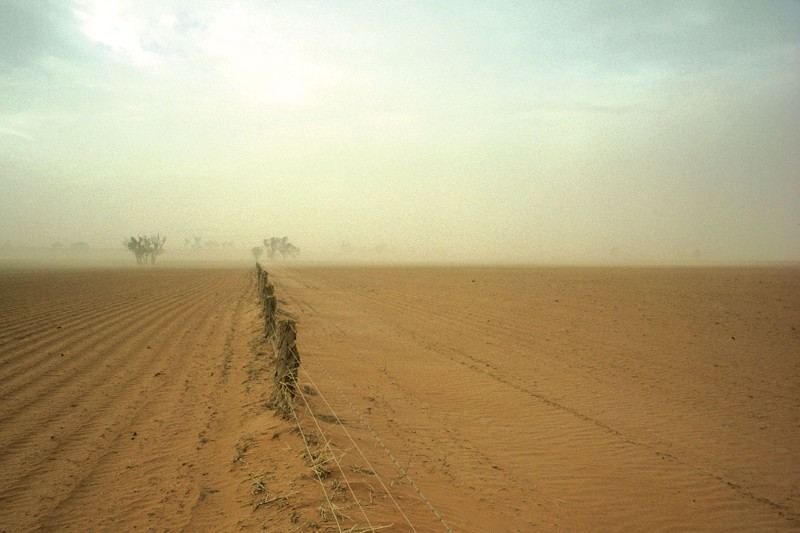
(Image: Auscape/Getty)
FIND the places where farms give way to the California wilderness and you’re sure to encounter an endangered species. It is not aggressive, but it is omnivorous, devouring anything that happens to fall dead within its reach. And like most rare beasts, the extinction of Abruptic durixeralfs would have cascading impacts on the ecosystem around it.
Don’t be misled by the name. This is neither animal nor plant nor microbe, but a subgroup of soils. Its members nonetheless slot into a classification system every bit as elaborate as that we use to categorise life forms. In the US alone, more than 20,000 soils have been catalogued. Many are facing extinction.
It may seem like madness to speak of soils going extinct, but more than a third of the world’s top layer is endangered, according to the UN, which declared 2015 the International Year of Soils. This December, it will release a much-anticipated report on the state of the world’s dirt. The news won’t be good: we are losing soil at a rate of 30 soccer fields a minute. If we don’t slow the decline, all farmable soil could be gone in 60 years. Given soil grows 95 per cent of our food, and sustains human life in other more surprising ways, that is a huge problem. “Many would argue soil degradation is the most critical environmental threat to humans,” says Peter Groffman, who studies soil microbes at the Cary Institute of Ecosystem Studies in Millbrook, New York. Yet all is not – quite – lost.
The degradation of the world’s dirt has been a disaster in slow motion. “Soil scientists have been prattling on about this for decades,” says Groffman. All the while, our understanding of just how crucial soil is has only grown. A single gram might contain 100 million bacteria, 10 million viruses, 1000 fungi, and other populations living amid decomposing plants and various rocks and minerals.
That means soils not just grow our food, but have been the source of nearly all of our existing antibiotics, and could be our best hope in the fight against antibiotic-resistant bacteria. Well-conditioned soil certainly seems to have ways to keep out dangerous elements. In 2011, a series of experiments at the University of Groningen in the Netherlands suggested that soil types with more diverse communities of microbes fare better at suppressing one strain of E. coli. This strain causes particularly violent diarrhoea and even kidney failure in humans, and the soil’s action could potentially prevent it entering the food chain. “There’s a clear link between soil microbial diversity, plant health and human health,” says Rick Ostfeld, who works with Groffman at the Cary Institute.
Soil is also a surprising ally against climate change: as nematodes and microorganisms within soil digest dead animals and plants, they lock in their carbon content. Even in their degraded state, it is estimated the world’s soils holdthree times the amount of carbon as does the entire atmosphere. Water storage is another talent lost when soils degrade. A UK government report published in 2012 suggested soil degradation costs the country £233 million in flood damage each year.
Small wonder endangered soil is making ecologists so nervous. It’s not that the dirt is wiped off the face of the planet. “When folks refer to the soil as endangered, they’re not thinking of it in the same sense as endangered species,” says Ostfeld. Rather, extinction transforms a fecund soil into a dusty, microbiologically flat shadow of its former self. Once that diversity is gone, it’s gone for a while. “Soil takes thousands of years at a minimum to gestate,” says Groffman.
Abruptic durixeralfs’s problem is that it is of little direct use for farming owing to its tendency to form a hardpan – a dense, compacted layer that repels both roots and water. But it likes to nestle between swathes of prime agricultural land in its habitats in the western US. Frustrated farmers have resorted to using explosives to blow it out of the way: a dramatic method of soil extinction, but only one of many. “Everything we do causes soil to erode,” says Groffman.
A load of manure
Agriculture is by far and away soil’s biggest problem. In the wild, nutrients removed by plants are returned to the soil when they die and decay to form rich humus. Humans tend not to return unused parts of harvested crops to replenish those nutrients.
We realised this long ago and developed strategies to get around the problem. We left fields fallow, or rotated crops that required different nutrients, thereby keeping the soil in balance. Growing peas and beans can even add
nitrogen, a vital nutrient, to the ground: nodules in their roots host rhizobia bacteria, which grab atmospheric nitrogen and convert it into nitrates.
But these practices became inconvenient as populations grew and agriculture was mechanised. A solution came in the early 20th century with the Haber-Bosch process for manufacturing ammonium nitrate. Farmers have been plying their fields with this synthetic fertiliser ever since.
But over the past few decades, it has become clear this wasn’t such a bright idea. Chemical fertilisers can release polluting nitrous oxide into the atmosphere and excess is often washed away with the next rain. This leaches nitrogen into rivers, damaging algal blooms. More recently, we have found that indiscriminate fertiliser use hurts the soil itself, turning it acidic and salty. It also suppresses symbiotic relationships between fungi and plant roots, and can even turn beneficial bacteria against each other
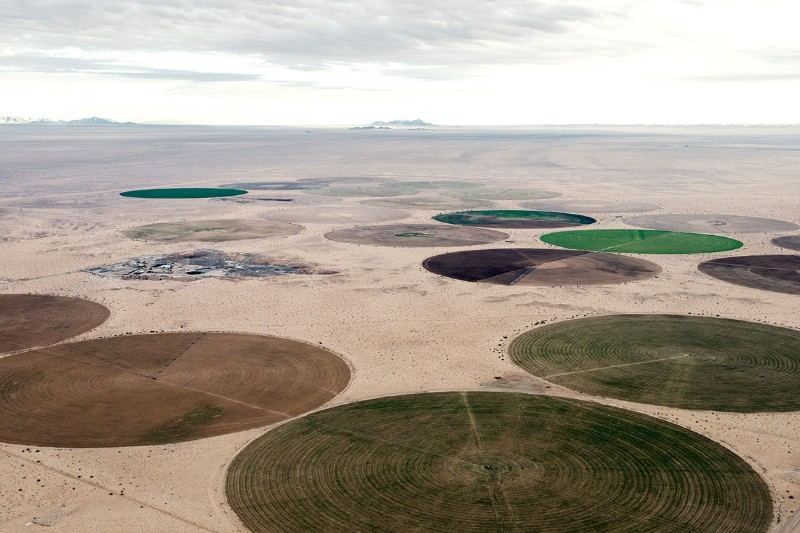
Long-term use of fertilisers risks turning even fertile soil to desert (Image: Pete Mcbride /National Geographic Creative)
In many ways, fertilisers speed the soil they are supposed to nourish toward extinction. “They really work to grow plants,” says Groffman. “So they very effectively hide the nature and extent of soil degradation. As the soil degrades, you just put on more fertiliser.”
What’s to do? One possible solution is being pursued by Carlos Monreal of Carleton University in Ottawa, Canada, and his colleagues. Inspired by the way plants coexist with soil bacteria, he is on a mission to make fertilisers smarter.
Monreal wants to exploit the way plants signal to bacteria by releasing chemicals. “The plant tells the microbes, ‘hey guys, I need nitrogen!'” he says. The microbes then begin working to free nitrogen from organic matter, and the plant soaks it up. In 2011, after nearly a decade of sifting through hundreds of chemicals in soil samples taken from fields of wheat and canola (oilseed rape), Monreal’s team identified five compounds that spike just as the plants take in ammonia – these are the chemical signals plants exude to ask for nitrogen.
Monreal then teamed up with Maria DeRosa, also at Carleton, to try to build a fertiliser that keeps its payload locked up until it encounters a plant’s signalling compounds. DeRosa turned to aptamers, short strands of DNA that bind to specific chemicals, much the way antibodies do. After training them to recognise the five compounds, she used the aptamers as scaffolding around a tiny parcel of fertiliser. In the presence of one of the plant signalling compounds, the aptamers would bind to it, rupturing the scaffolding and releasing its contents.
The pair now have a working product, fertiliser-filled capsules that open up in response to the appetite wheat and canola have for nitrogen. Monreal thinks the same process will work with other crops and soil microbes too – although the precise details are under wraps while they try to commercialise the technology. First, it must undergo greenhouse trials, scheduled for spring 2016, and pass other tests to make sure it biodegrades after a few years in the soil. Several groups are working on similar approaches to reduce the environmental impact of fertilisers and even pesticides.
Another school of thought says that any synthetic fertiliser, even in small doses, is bound ultimately to degrade the soil. Such concerns might be addressed by an alternative approach, which replaces synthetic fertilisers and chemical pesticides with the soil’s own microbiome.
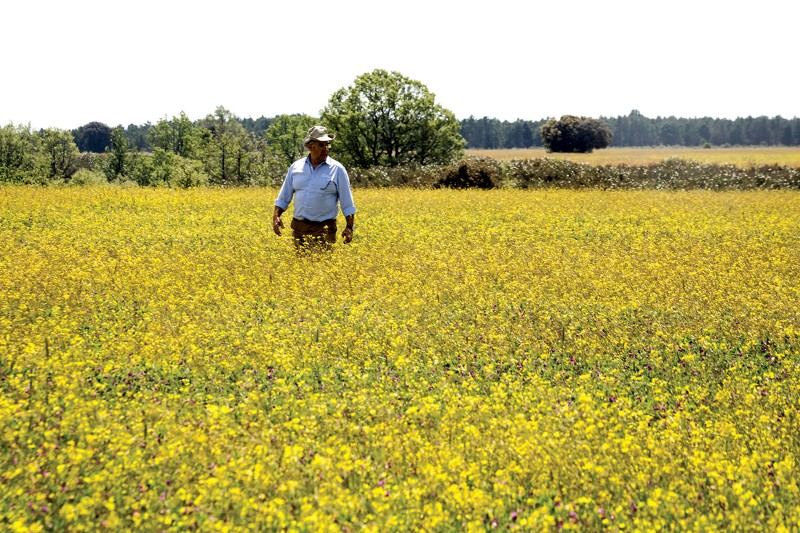
Pius Floris hopes to use soils’ own microbes to maintain their fertility (Image: Photographs by Photogenic Agencia Gráfica)
This research is in its early days, and Pius Floris is one of the people at its vanguard. Floris, who started out running a tree-care business in the Netherlands, now advises some of the world’s top soil scientists. He came to realise that the best way to ensure his trees flourished was to take very particular care of the soil, and has developed what he calls a “universal recipe” of beneficial bacteria, mycorrhizal fungi and humus that adheres to plant roots and helps them extract nutrients.
Under the auspices of a European Union-funded pilot project to resuscitate degraded soils, Floris recently teamed up with researchers at the University of Valladolid in Spain to test this cocktail on local soils whose ability to grow plants had been destroyed by years of fertiliser and pesticide overuse. When the team applied Floris’s mix to the desert-like test plots, they began to sprout oats and leguminous plants called vetches. The few plants that grew in the control plots, dosed with traditional pesticides and fertilisers, were small and stunted; those treated with Floris’ cocktail were not just healthy at the surface, but their roots had grown strong and long enough to pierce dirt as hard as rock.
Dish the dirt
The promise of these microbial interventions is such that agrochemical companies are taking notice. Microbe-based fertilisers are being developed by chemical giants such as Dupont as well as small start-ups. Several countries, including India, have programmes to foster their use by farmers.
Innovative as they are, these measures will at best make a dent in the global soil degradation problem. “There are some problems you can’t invent your way out of,” says soil hydrologist Dara Entekhabi at the Massachusetts Institute of Technology. Soil degradation is a complex issue with tendrils poking into areas like climate change, biodiversity, food security and water (see map). Better fertilisers won’t stop the drought that is ruining soils in California, or avert bulldozers paving over them in rapidly-urbanising China.
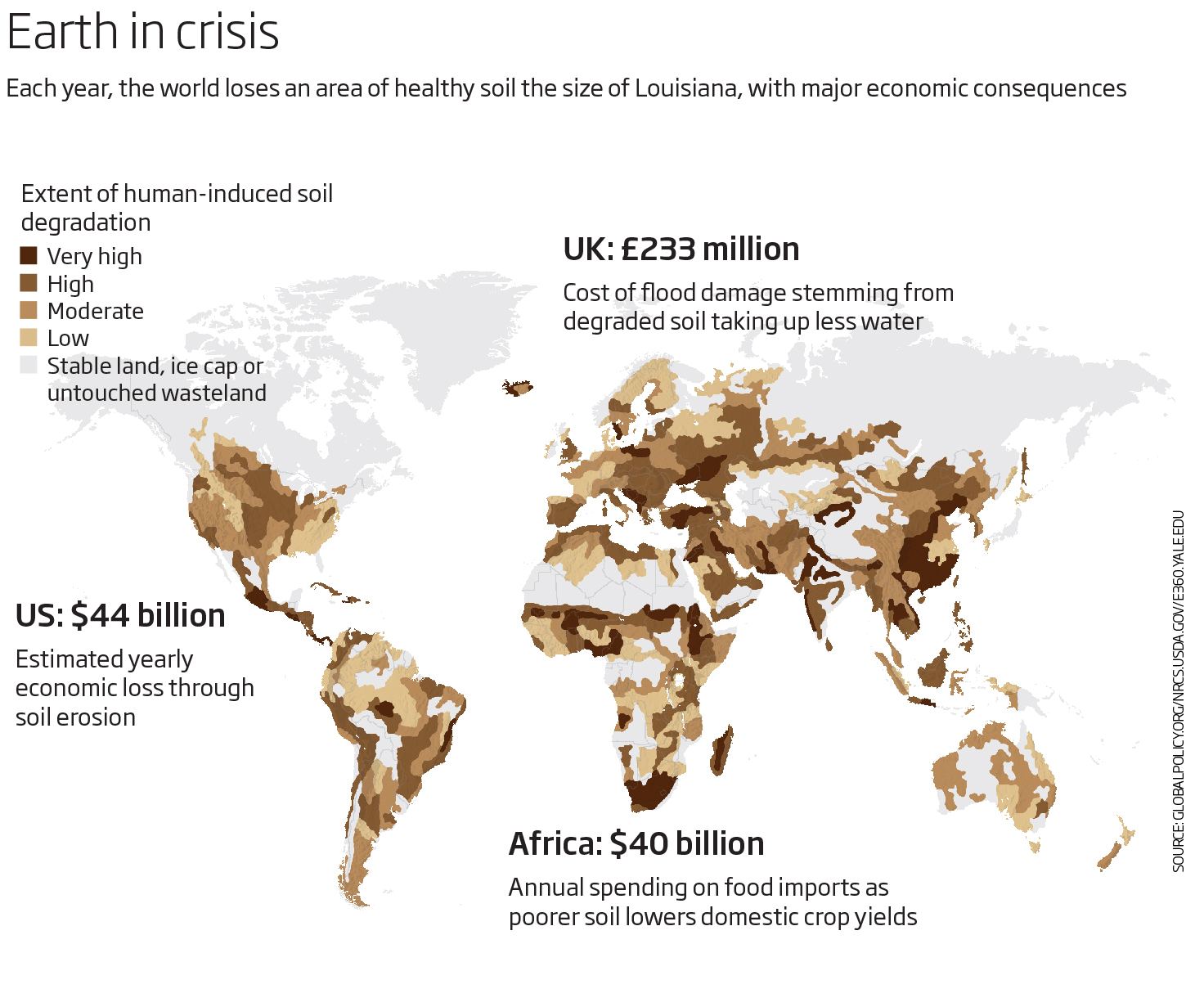
To assess our options on a global scale we first need an accurate picture of what soils are out there, and which are endangered. That’s not easy. For one thing, it still requires extensive fieldwork; for another, there is no agreed international system for classifying soil (see “How to organise the earth“).
In an attempt to unify all the different approaches, in 2010 the UN created the Global Soil Map project. Researchers from nine countries are working together to create a real-time, digital repository of the condition of soils worldwide. Right now, the state of the art is a map with a resolution of 1 kilometre, linked to an online database that can be fed measurements – field surveys, drone surveys, satellite imagery, lab analyses and so on – at any resolution. Cross-referenced with existing data, it provides real-time predictions of soil health: its clay, silt and organic carbon levels, together with acidity and overall density. By 2019, researchers aim to have mapped soils worldwide down to 100 metres, with the results freely accessible to all.
But sophisticated new ways to classify and map soils is only a first step. Action will require ways of presenting the problem that bring it home to governments and the wider public, says Pamela Chasek at the International Institute for Sustainable Development, a think tank headquartered in Winnipeg, Canada. “Most scientists don’t speak language that policy-makers can understand, and vice versa.” Chasek and her colleagues have proposed a goal of “zero net land degradation“. Like the idea of carbon neutrality, it is an easily understood target that can help shape expectations and encourage action. It would also offer a banner under which projects like Monreal’s and Floris’ can rally.
“Knowing what soils are where is only a first step to action”
For soils on the brink, that may be too late. Several researchers are agitating for the creation of protected zones for endangered soils, although there has been little official movement on the issue so far. One problem is defining what these areas should conserve: areas where the greatest soil diversity is present? Or areas of pristine soils that could act as a future benchmark of quality?
The US has made an effort to at least recognise the importance of soils, by having every state designate a “state soil”. California’s is the San Joaquin – which, ironically, is an informal name for a soil that belongs to the group frequently in local farmers’ crosshairs: Abruptic durixeralfs. When law-makers made it the state soil in 1997, they didn’t accompany the honour with any legal protection. That’s telling. If we do want to save our soils, we might want to stop treating them like dirt.
How to organise the earth
By Joshua Howgego
Just as living things are sorted into orders, genera and species, so soil has its own categorisation systems. The US Department of Agriculture, for example, breaks it down into orders, suborders, great groups, subgroups, families and finally series – the equivalent of a species. The classification criteria are based both on physical characteristics and more subtle factors. The parent material the soil is made from, the microbes living within it, the topography of the land, the climate and the soil’s age are all important.
Characterising soils has flagged a few in danger. In 2003 for instance, researchers found that almost 5 per cent of US soils were in danger of serious damage or extinction caused by agriculture or construction, although that may well be an underestimate. A different group scoured soil survey results in China, and found 17 types had gone extinct, and a further 88 were endangered.
...
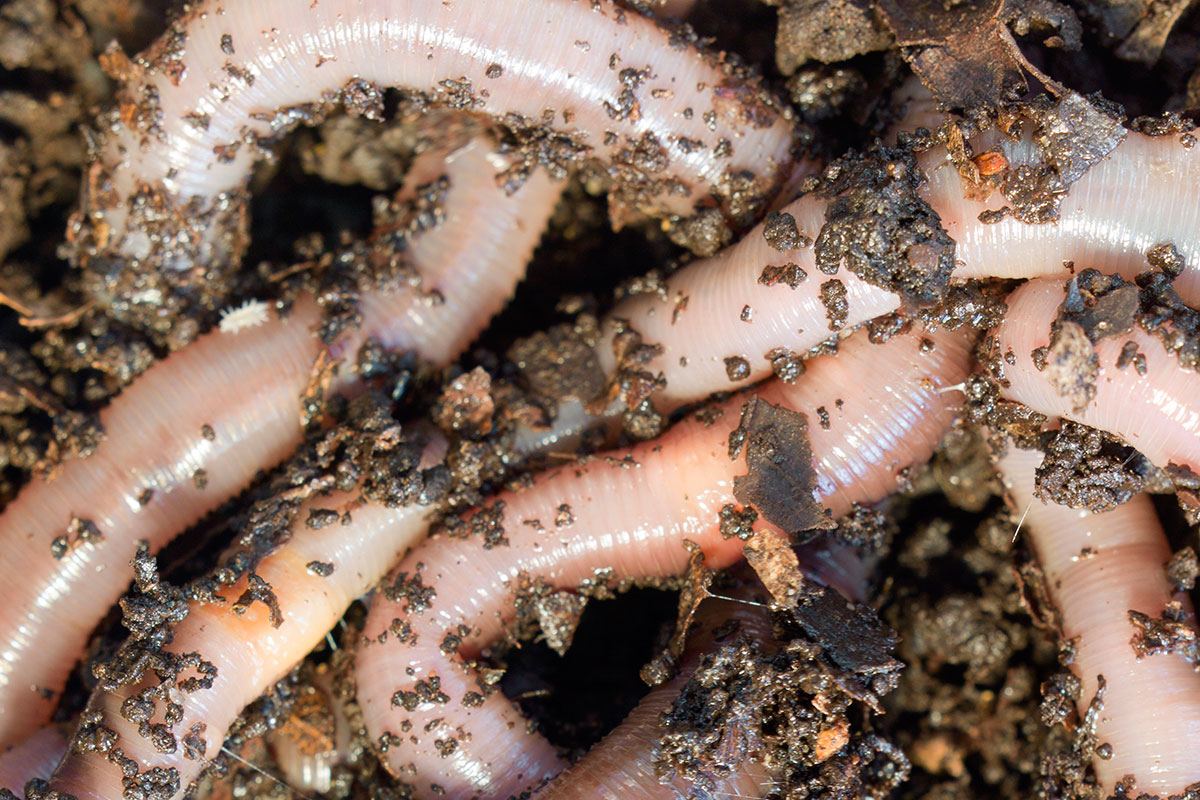
1. Earthworms
Charles Darwin called them "nature's ploughs", and the earthworms that tirelessly tunnel around in the rhizosphere help water and oxygen to penetrate the soil. They eat decomposing plant matter, and their excretions are perfect food for bacteria and fungi, which unlock the nutrients for use by plants.
(Image: Dr Jeremy Burgess/SPL)
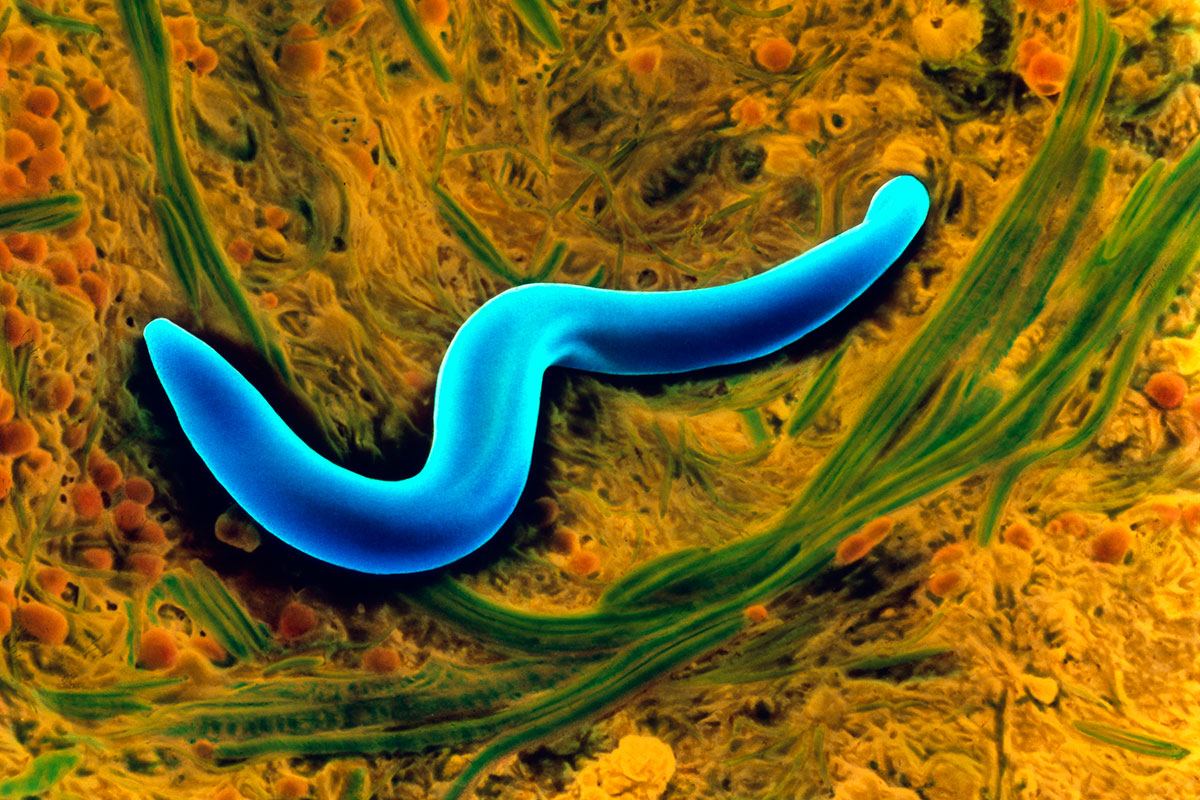
2. Nematodes
If earthworms are living ploughs, then nematodes are nature's pesticides. The majority of these microscopic worms are considered beneficial: they seek out and destroy 200 species of plant pests, including gnats, grubs, flies and fleas. They're so good at their job that some people use them as a natural form of pest control.
(Image: Microfield Scientific Ltd/SPL)
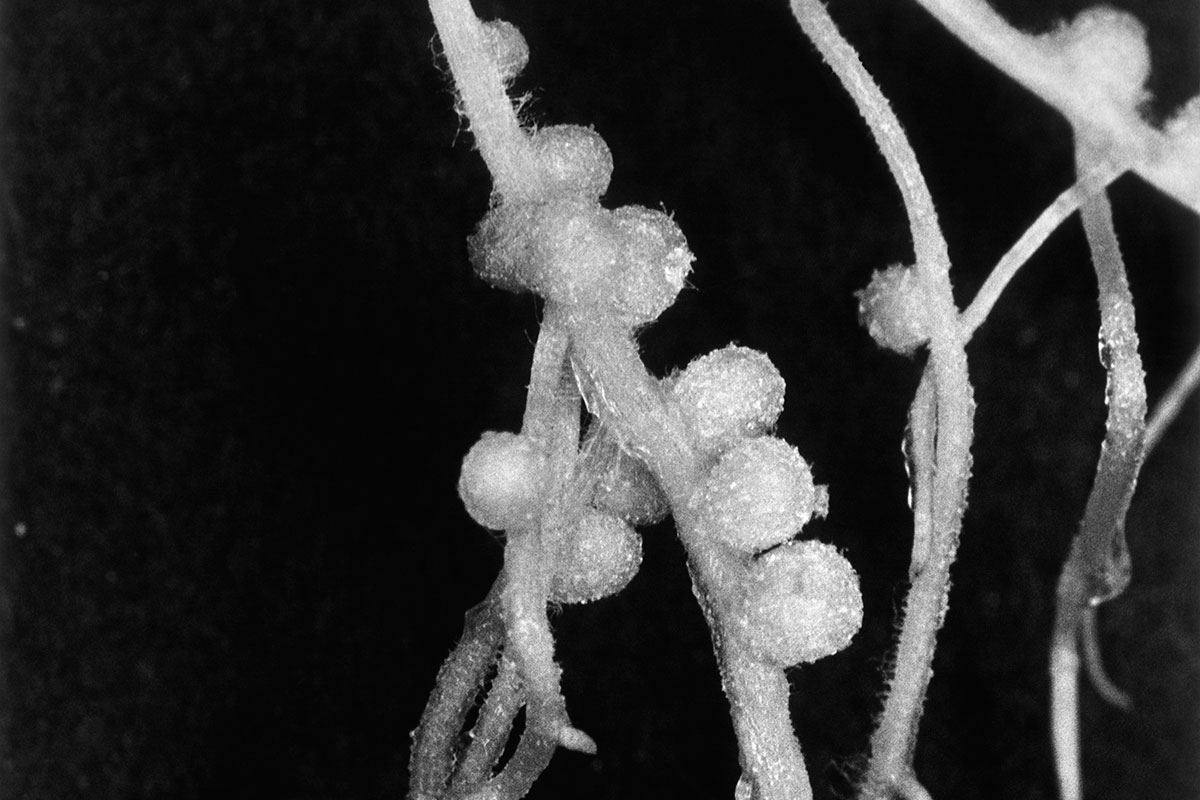
3. Rhizobacteria
Nature's fertiliser, this group of bacteria colonises the root nodules of legumes including peas and beans. They live symbiotically with the plant, converting atmospheric nitrogen into something it can metabolise.
(Image: Dr Jeremy Burgess/SPL)
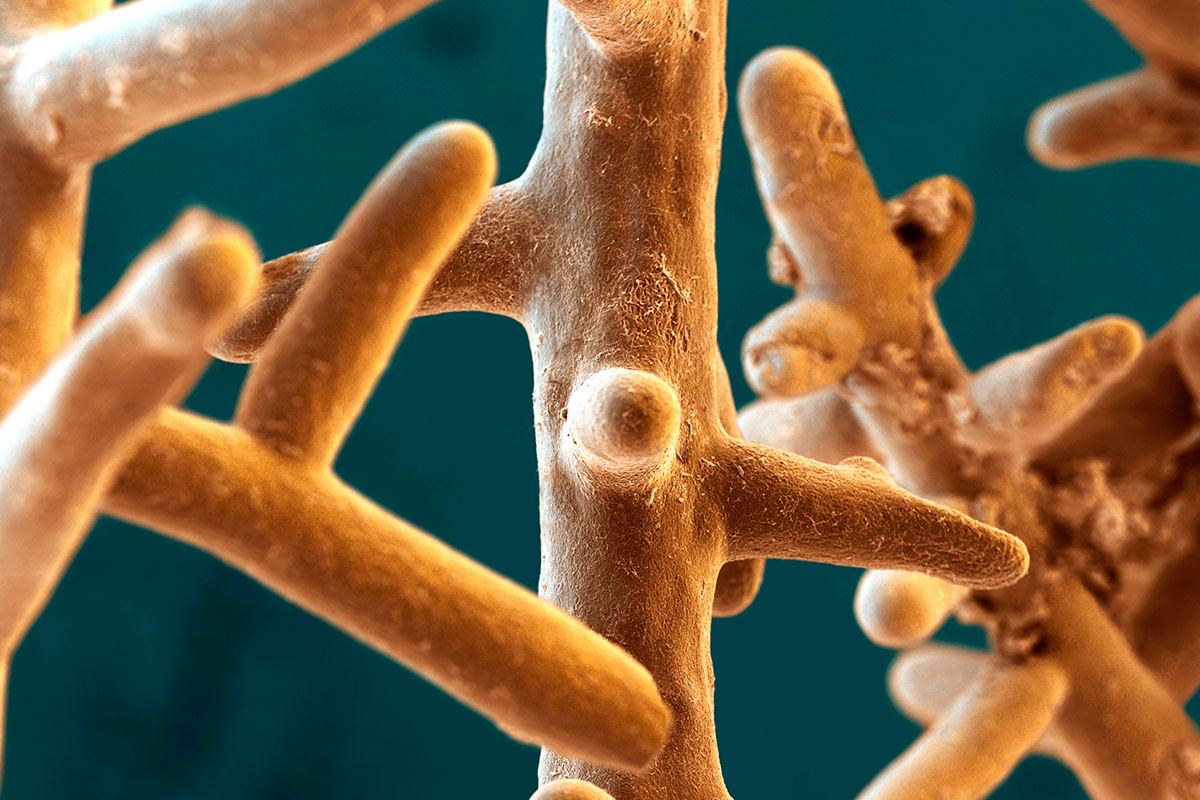
4. Mycorrhizal fungi
These, too, form symbiotic relationships with plants, attaching to their roots and helping them to pierce tough soil to reach water deep down. In return, the fungi takes a cut of the sugars that the plant produces through photosynthesis.
(Image: Eye of Science/SPL)
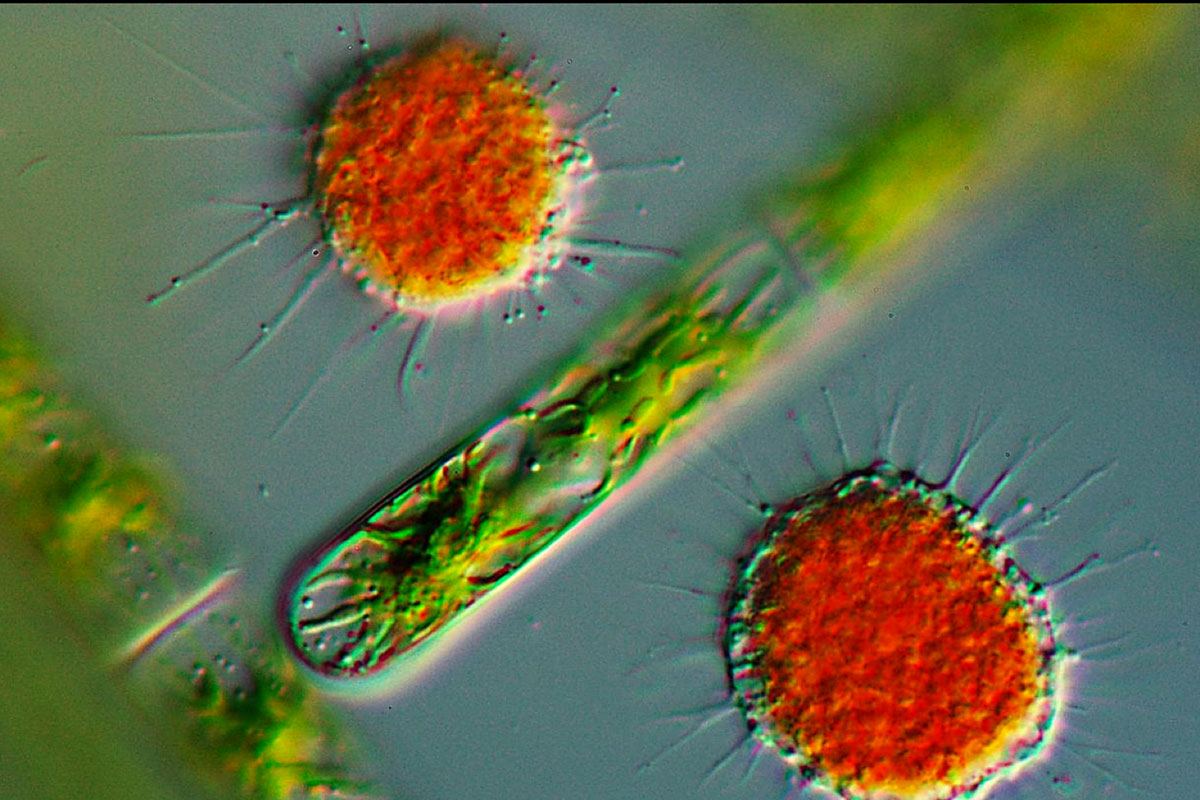
7. Vampyrellids
These amoebae eat fungi, unlike most of their fellow soil protozoa, which snack on bacteria. Their name derives from the characteristic mark of a vampyrellid attack – perfectly round holes drilled through the fungal cell wall, resembling the marks adorning the neck of a vampire's victim. As they eat, they release excess nitrogen into the soil for plants to use.
(Image: Sebastian Hess)
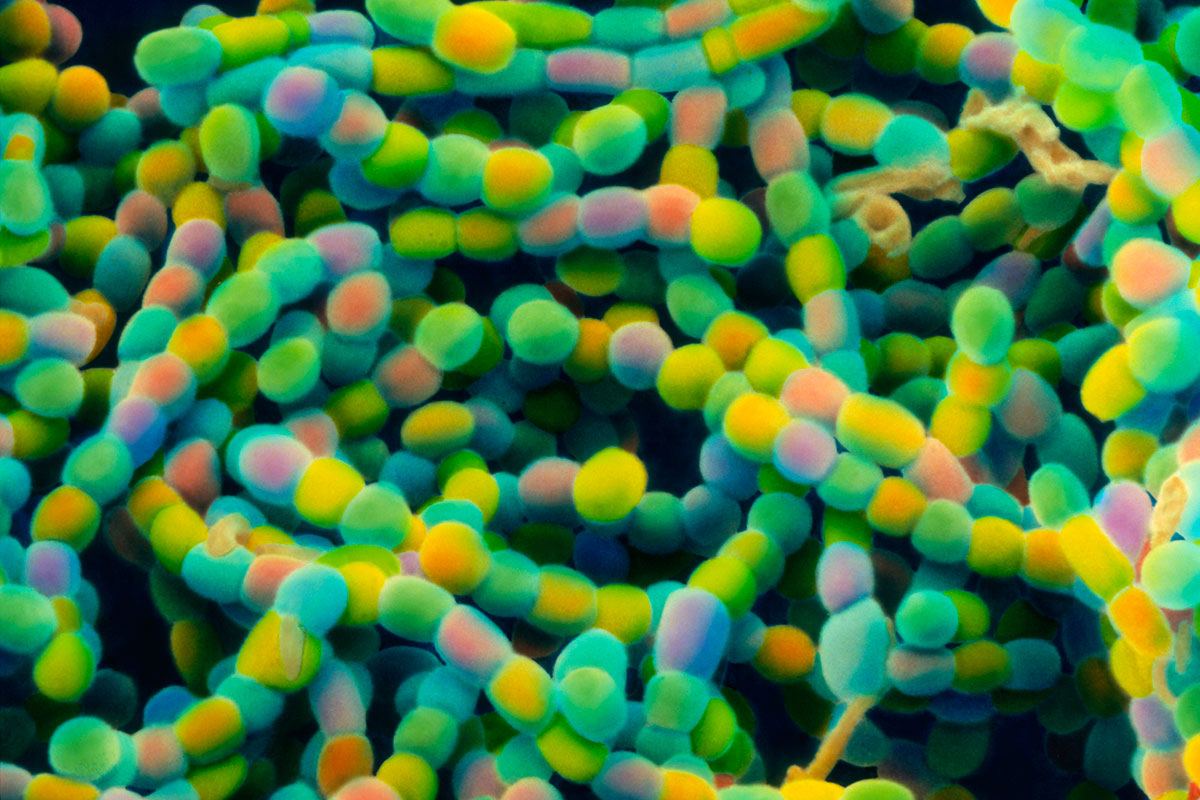
6. Streptomyces bacteria
These bacteria appear to have more in common with fungi than other bacteria – they grow in branching filaments and form spores. They also produce various antibiotic compounds, including streptomycin, which can kill certain strains of E. coli that contaminate vegetables. It's an example of the specialised bacterial communities that plants attract to protect themselves.
(Image: Microfield Scientific Ltd/SPL)
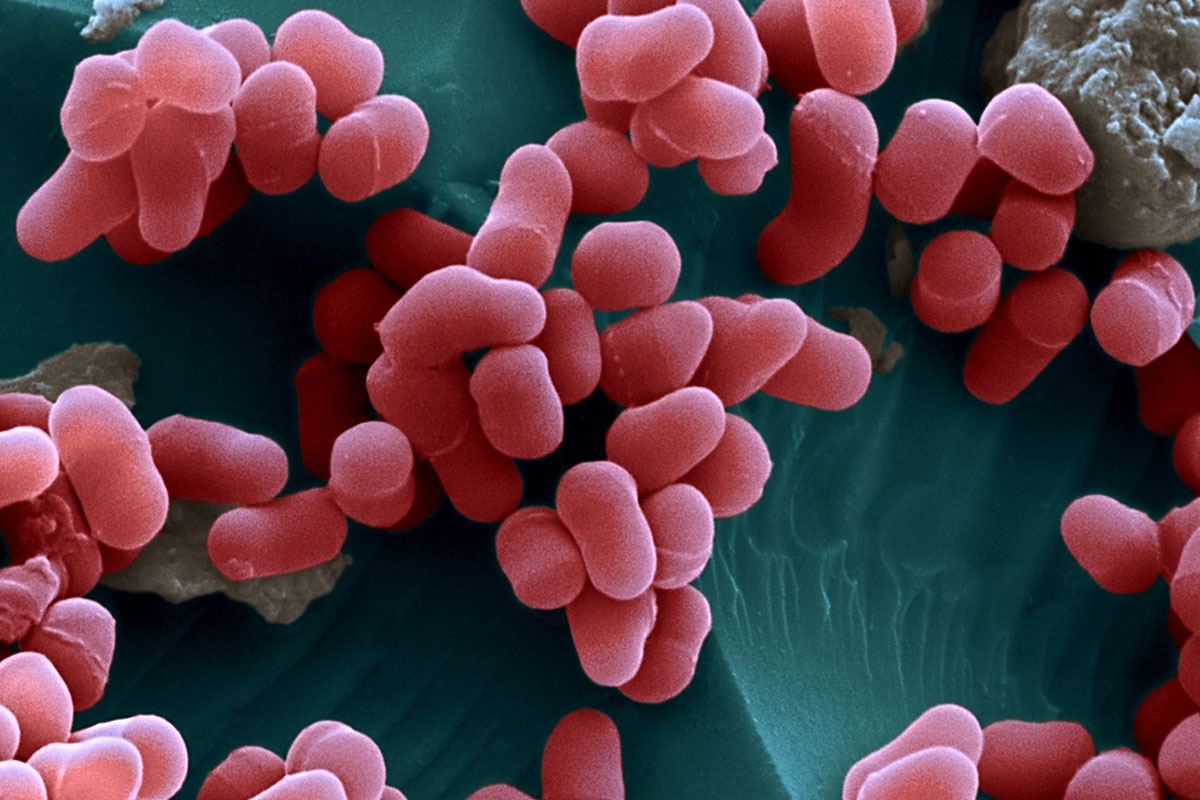
5. Arthrobacter crystallopoietes
This is one of a number of types of bacteria that can reduce soil contamination – in this particular case, hexavalent chromium compounds, which raise the risk of certain cancers. That makes Arthrobacter an attractive candidate for natural bioremediation, stopping hexavalent chromium leaching into reservoirs.
https://www.newscientist.com/articl...ed-earth-the-secret-battle-to-save-our-soils/

(Image: Auscape/Getty)
FIND the places where farms give way to the California wilderness and you’re sure to encounter an endangered species. It is not aggressive, but it is omnivorous, devouring anything that happens to fall dead within its reach. And like most rare beasts, the extinction of Abruptic durixeralfs would have cascading impacts on the ecosystem around it.
Don’t be misled by the name. This is neither animal nor plant nor microbe, but a subgroup of soils. Its members nonetheless slot into a classification system every bit as elaborate as that we use to categorise life forms. In the US alone, more than 20,000 soils have been catalogued. Many are facing extinction.
It may seem like madness to speak of soils going extinct, but more than a third of the world’s top layer is endangered, according to the UN, which declared 2015 the International Year of Soils. This December, it will release a much-anticipated report on the state of the world’s dirt. The news won’t be good: we are losing soil at a rate of 30 soccer fields a minute. If we don’t slow the decline, all farmable soil could be gone in 60 years. Given soil grows 95 per cent of our food, and sustains human life in other more surprising ways, that is a huge problem. “Many would argue soil degradation is the most critical environmental threat to humans,” says Peter Groffman, who studies soil microbes at the Cary Institute of Ecosystem Studies in Millbrook, New York. Yet all is not – quite – lost.
The degradation of the world’s dirt has been a disaster in slow motion. “Soil scientists have been prattling on about this for decades,” says Groffman. All the while, our understanding of just how crucial soil is has only grown. A single gram might contain 100 million bacteria, 10 million viruses, 1000 fungi, and other populations living amid decomposing plants and various rocks and minerals.
That means soils not just grow our food, but have been the source of nearly all of our existing antibiotics, and could be our best hope in the fight against antibiotic-resistant bacteria. Well-conditioned soil certainly seems to have ways to keep out dangerous elements. In 2011, a series of experiments at the University of Groningen in the Netherlands suggested that soil types with more diverse communities of microbes fare better at suppressing one strain of E. coli. This strain causes particularly violent diarrhoea and even kidney failure in humans, and the soil’s action could potentially prevent it entering the food chain. “There’s a clear link between soil microbial diversity, plant health and human health,” says Rick Ostfeld, who works with Groffman at the Cary Institute.
Soil is also a surprising ally against climate change: as nematodes and microorganisms within soil digest dead animals and plants, they lock in their carbon content. Even in their degraded state, it is estimated the world’s soils holdthree times the amount of carbon as does the entire atmosphere. Water storage is another talent lost when soils degrade. A UK government report published in 2012 suggested soil degradation costs the country £233 million in flood damage each year.
Small wonder endangered soil is making ecologists so nervous. It’s not that the dirt is wiped off the face of the planet. “When folks refer to the soil as endangered, they’re not thinking of it in the same sense as endangered species,” says Ostfeld. Rather, extinction transforms a fecund soil into a dusty, microbiologically flat shadow of its former self. Once that diversity is gone, it’s gone for a while. “Soil takes thousands of years at a minimum to gestate,” says Groffman.
Abruptic durixeralfs’s problem is that it is of little direct use for farming owing to its tendency to form a hardpan – a dense, compacted layer that repels both roots and water. But it likes to nestle between swathes of prime agricultural land in its habitats in the western US. Frustrated farmers have resorted to using explosives to blow it out of the way: a dramatic method of soil extinction, but only one of many. “Everything we do causes soil to erode,” says Groffman.
A load of manure
Agriculture is by far and away soil’s biggest problem. In the wild, nutrients removed by plants are returned to the soil when they die and decay to form rich humus. Humans tend not to return unused parts of harvested crops to replenish those nutrients.
We realised this long ago and developed strategies to get around the problem. We left fields fallow, or rotated crops that required different nutrients, thereby keeping the soil in balance. Growing peas and beans can even add
nitrogen, a vital nutrient, to the ground: nodules in their roots host rhizobia bacteria, which grab atmospheric nitrogen and convert it into nitrates.
But these practices became inconvenient as populations grew and agriculture was mechanised. A solution came in the early 20th century with the Haber-Bosch process for manufacturing ammonium nitrate. Farmers have been plying their fields with this synthetic fertiliser ever since.
But over the past few decades, it has become clear this wasn’t such a bright idea. Chemical fertilisers can release polluting nitrous oxide into the atmosphere and excess is often washed away with the next rain. This leaches nitrogen into rivers, damaging algal blooms. More recently, we have found that indiscriminate fertiliser use hurts the soil itself, turning it acidic and salty. It also suppresses symbiotic relationships between fungi and plant roots, and can even turn beneficial bacteria against each other

Long-term use of fertilisers risks turning even fertile soil to desert (Image: Pete Mcbride /National Geographic Creative)
In many ways, fertilisers speed the soil they are supposed to nourish toward extinction. “They really work to grow plants,” says Groffman. “So they very effectively hide the nature and extent of soil degradation. As the soil degrades, you just put on more fertiliser.”
What’s to do? One possible solution is being pursued by Carlos Monreal of Carleton University in Ottawa, Canada, and his colleagues. Inspired by the way plants coexist with soil bacteria, he is on a mission to make fertilisers smarter.
Monreal wants to exploit the way plants signal to bacteria by releasing chemicals. “The plant tells the microbes, ‘hey guys, I need nitrogen!'” he says. The microbes then begin working to free nitrogen from organic matter, and the plant soaks it up. In 2011, after nearly a decade of sifting through hundreds of chemicals in soil samples taken from fields of wheat and canola (oilseed rape), Monreal’s team identified five compounds that spike just as the plants take in ammonia – these are the chemical signals plants exude to ask for nitrogen.
Monreal then teamed up with Maria DeRosa, also at Carleton, to try to build a fertiliser that keeps its payload locked up until it encounters a plant’s signalling compounds. DeRosa turned to aptamers, short strands of DNA that bind to specific chemicals, much the way antibodies do. After training them to recognise the five compounds, she used the aptamers as scaffolding around a tiny parcel of fertiliser. In the presence of one of the plant signalling compounds, the aptamers would bind to it, rupturing the scaffolding and releasing its contents.
The pair now have a working product, fertiliser-filled capsules that open up in response to the appetite wheat and canola have for nitrogen. Monreal thinks the same process will work with other crops and soil microbes too – although the precise details are under wraps while they try to commercialise the technology. First, it must undergo greenhouse trials, scheduled for spring 2016, and pass other tests to make sure it biodegrades after a few years in the soil. Several groups are working on similar approaches to reduce the environmental impact of fertilisers and even pesticides.
Another school of thought says that any synthetic fertiliser, even in small doses, is bound ultimately to degrade the soil. Such concerns might be addressed by an alternative approach, which replaces synthetic fertilisers and chemical pesticides with the soil’s own microbiome.

Pius Floris hopes to use soils’ own microbes to maintain their fertility (Image: Photographs by Photogenic Agencia Gráfica)
This research is in its early days, and Pius Floris is one of the people at its vanguard. Floris, who started out running a tree-care business in the Netherlands, now advises some of the world’s top soil scientists. He came to realise that the best way to ensure his trees flourished was to take very particular care of the soil, and has developed what he calls a “universal recipe” of beneficial bacteria, mycorrhizal fungi and humus that adheres to plant roots and helps them extract nutrients.
Under the auspices of a European Union-funded pilot project to resuscitate degraded soils, Floris recently teamed up with researchers at the University of Valladolid in Spain to test this cocktail on local soils whose ability to grow plants had been destroyed by years of fertiliser and pesticide overuse. When the team applied Floris’s mix to the desert-like test plots, they began to sprout oats and leguminous plants called vetches. The few plants that grew in the control plots, dosed with traditional pesticides and fertilisers, were small and stunted; those treated with Floris’ cocktail were not just healthy at the surface, but their roots had grown strong and long enough to pierce dirt as hard as rock.
Dish the dirt
The promise of these microbial interventions is such that agrochemical companies are taking notice. Microbe-based fertilisers are being developed by chemical giants such as Dupont as well as small start-ups. Several countries, including India, have programmes to foster their use by farmers.
Innovative as they are, these measures will at best make a dent in the global soil degradation problem. “There are some problems you can’t invent your way out of,” says soil hydrologist Dara Entekhabi at the Massachusetts Institute of Technology. Soil degradation is a complex issue with tendrils poking into areas like climate change, biodiversity, food security and water (see map). Better fertilisers won’t stop the drought that is ruining soils in California, or avert bulldozers paving over them in rapidly-urbanising China.

To assess our options on a global scale we first need an accurate picture of what soils are out there, and which are endangered. That’s not easy. For one thing, it still requires extensive fieldwork; for another, there is no agreed international system for classifying soil (see “How to organise the earth“).
In an attempt to unify all the different approaches, in 2010 the UN created the Global Soil Map project. Researchers from nine countries are working together to create a real-time, digital repository of the condition of soils worldwide. Right now, the state of the art is a map with a resolution of 1 kilometre, linked to an online database that can be fed measurements – field surveys, drone surveys, satellite imagery, lab analyses and so on – at any resolution. Cross-referenced with existing data, it provides real-time predictions of soil health: its clay, silt and organic carbon levels, together with acidity and overall density. By 2019, researchers aim to have mapped soils worldwide down to 100 metres, with the results freely accessible to all.
But sophisticated new ways to classify and map soils is only a first step. Action will require ways of presenting the problem that bring it home to governments and the wider public, says Pamela Chasek at the International Institute for Sustainable Development, a think tank headquartered in Winnipeg, Canada. “Most scientists don’t speak language that policy-makers can understand, and vice versa.” Chasek and her colleagues have proposed a goal of “zero net land degradation“. Like the idea of carbon neutrality, it is an easily understood target that can help shape expectations and encourage action. It would also offer a banner under which projects like Monreal’s and Floris’ can rally.
“Knowing what soils are where is only a first step to action”
For soils on the brink, that may be too late. Several researchers are agitating for the creation of protected zones for endangered soils, although there has been little official movement on the issue so far. One problem is defining what these areas should conserve: areas where the greatest soil diversity is present? Or areas of pristine soils that could act as a future benchmark of quality?
The US has made an effort to at least recognise the importance of soils, by having every state designate a “state soil”. California’s is the San Joaquin – which, ironically, is an informal name for a soil that belongs to the group frequently in local farmers’ crosshairs: Abruptic durixeralfs. When law-makers made it the state soil in 1997, they didn’t accompany the honour with any legal protection. That’s telling. If we do want to save our soils, we might want to stop treating them like dirt.
How to organise the earth
By Joshua Howgego
Just as living things are sorted into orders, genera and species, so soil has its own categorisation systems. The US Department of Agriculture, for example, breaks it down into orders, suborders, great groups, subgroups, families and finally series – the equivalent of a species. The classification criteria are based both on physical characteristics and more subtle factors. The parent material the soil is made from, the microbes living within it, the topography of the land, the climate and the soil’s age are all important.
Characterising soils has flagged a few in danger. In 2003 for instance, researchers found that almost 5 per cent of US soils were in danger of serious damage or extinction caused by agriculture or construction, although that may well be an underestimate. A different group scoured soil survey results in China, and found 17 types had gone extinct, and a further 88 were endangered.
...

1. Earthworms
Charles Darwin called them "nature's ploughs", and the earthworms that tirelessly tunnel around in the rhizosphere help water and oxygen to penetrate the soil. They eat decomposing plant matter, and their excretions are perfect food for bacteria and fungi, which unlock the nutrients for use by plants.
(Image: Dr Jeremy Burgess/SPL)

2. Nematodes
If earthworms are living ploughs, then nematodes are nature's pesticides. The majority of these microscopic worms are considered beneficial: they seek out and destroy 200 species of plant pests, including gnats, grubs, flies and fleas. They're so good at their job that some people use them as a natural form of pest control.
(Image: Microfield Scientific Ltd/SPL)

3. Rhizobacteria
Nature's fertiliser, this group of bacteria colonises the root nodules of legumes including peas and beans. They live symbiotically with the plant, converting atmospheric nitrogen into something it can metabolise.
(Image: Dr Jeremy Burgess/SPL)

4. Mycorrhizal fungi
These, too, form symbiotic relationships with plants, attaching to their roots and helping them to pierce tough soil to reach water deep down. In return, the fungi takes a cut of the sugars that the plant produces through photosynthesis.
(Image: Eye of Science/SPL)

7. Vampyrellids
These amoebae eat fungi, unlike most of their fellow soil protozoa, which snack on bacteria. Their name derives from the characteristic mark of a vampyrellid attack – perfectly round holes drilled through the fungal cell wall, resembling the marks adorning the neck of a vampire's victim. As they eat, they release excess nitrogen into the soil for plants to use.
(Image: Sebastian Hess)

6. Streptomyces bacteria
These bacteria appear to have more in common with fungi than other bacteria – they grow in branching filaments and form spores. They also produce various antibiotic compounds, including streptomycin, which can kill certain strains of E. coli that contaminate vegetables. It's an example of the specialised bacterial communities that plants attract to protect themselves.
(Image: Microfield Scientific Ltd/SPL)

5. Arthrobacter crystallopoietes
This is one of a number of types of bacteria that can reduce soil contamination – in this particular case, hexavalent chromium compounds, which raise the risk of certain cancers. That makes Arthrobacter an attractive candidate for natural bioremediation, stopping hexavalent chromium leaching into reservoirs.
https://www.newscientist.com/articl...ed-earth-the-secret-battle-to-save-our-soils/





